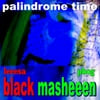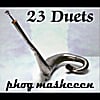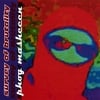There was a point in the show last night where I was charmed to death by the inland empire noise sensation Ralph Love as he deconstructed industrial rock with a great sound set of industrial samples. I love industrial rock so it was a trip down memory lane for me.
I did an interview with the Legendary Sander Wolff for the Long Beach Post.
The link is the word interview in the previous sentence and the cut and paste is below. The cut and paste is a little jumpy. The interview link is better and has video.
Phog Masheeen: Music Between The Cracks The Puka Bar, located at 710 W Willow, is presenting another installment of its First Mondays' Experimental Music Evenings tonight. One of tonight's performances will be by phog masheeen, fresh from a trek to the Bay Area for a series of shows. Sander: How was San Francisco? Phog: It was great! The Outsound New Music Summit starts with an event called "Touch the Gear" That happened Sunday the 18th at the Community Music Center on Capp St. in San Francisco. I flew myself and my gear up there to participate. The Gear thing was amazing! Some really great ideas. The really informative part was watching other people use my gear. Sander: What did you discover? Phog: People hit all the buttons at once. and rather than subtle fading, they sweep the pots the full distance to see what it does. Some people play a sampler like a piano. amazing! Phog: I am back down to collect the rest of the stuff, and Dr. Kaplan, and will head back up to SF to see the Thursday and Friday Shows and to perform on Saturday. Monday we are performing at the Puka Bar in Long Beach. There is some driving involved this week. Sander: So, you left your gear up there? Phog: Some. I am bringing up an aerophone that we call "the duodenum" that is more than I think the TSA could deal with. It is constructed from a Motorcycle exhaust pipe with a trumpet mouthpiece receiver in it. I am bringing a propane torch to warm the duodenum before massaging it with dry ice. Flying with that is a non-starter. Sander: Aside from being cold, what does the dry ice do? Phog: When the dry ice touches metal it boils. The difference in temperature between the ice and the metal determines how fast it boils. When dry ice boils the escaping gas vibrates the metal and the sound can be picked up with a contact mic. It works with the trumpet too. I don't use the propane on the trumpet, though. The results are truly out of control. I can select the location of the noise that is produced, but it is very hard to say that I can control what that noise is. The whole process keeps me on my toes. Also I use welding gloves to handle the dry ice. That adds an interesting spin to things as well. Sander: And how does the propane come into this equation? Phog: I use the torch to heat spots on the duodenum to provide nodes of heat on the metal. At that point I can use a strumming motion with the ice. I use the propane only to heat the metal. Sander: I really do think you should fly with your gear, just to see what happens! (You've seen Midnight Express, right?) Phog: I already get the little "you have been searched" pamphlets. I would need to be going somewhere really cool to push the envelope with the TSA. One more thing about the TSA: They disassembled a rack of gear and they couldn't put it back together again. So they put it in grey buckets and sent it to the luggage carousel. Not a pretty sight to see. That was after a red-eye to Philly. Sander: Let's talk, for a moment, about the 'Noise' genre. Do you feel that what you do is music, or is it a non-musical sonic experience? I ask because I feel that there are certainly components or elements of music in what you do. Phog: I work in a variety of legit musical settings. I feel the noise/sound design genre offers an opportunity to communicate emotion without diatonic concerns, or beat. I consider it music between the cracks. Can I do it without chords, melody, and beat, and use texture and color to communicate [instead]? Painters can. I think musicians can, too. Sander: That's why I struggle with 'noise' as a genre. I think it doesn't really do justice to the compositional, tonal, textural, and dynamic planning that goes into most performances. Phog: I would agree with that with some performers. For some, NOISE is really all they want to do. I am fine with that. I think it is inspiring to see what people can do with simple means or clever manipulation of gear. I am totally unqualified to speak for any genre. However, in my work I appreciate the surprises of working in the moment. I think that the audience is aware of how far out on the plank you are, and that brings some excitement to the performance. In reference to doing justice to the tonal, textural, and dynamic planning: That may or may not apply to all performers. Sander: There is a sense of play, of being completely in the moment, that seems to intrigue artists who work in experimental performance of one sort or another. Can you talk a bit more about that? Phog: The play aspect is more evident for me in long form settings. We were at Torrance Art Museum a couple of weeks ago and we had five hours to fill with sound. At that point you are looking at your collaborators' ideas and seeing if there is a way to re-combine, or twist, their idea and take it in a different direction to fill the five hours. That is more playful. In short form settings, say twenty minutes, I work to maintain focus and continuity. To maintain a story arc from one end of the performance to the other. I generally have some texture ideas at the outset but, if the plan isn't working, the plan goes. None of this "stay the course" crap. If my initial concept doesn't click right away, then I will go with no concept at all and see where that leads. You can't do experimental music if you don't do experiments. Some of them fail. It is the way they fail that brings people to noise shows. It is like going to NASCAR to see the wrecks. |



.jpg)



No comments:
Post a Comment